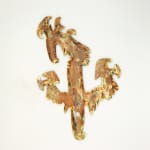Mayan Eccentric Flint , 600 CE - 900 CE
Chalcedony
26.5 x 17.5 x 0.3 cm
10 3/8 x 6 7/8 x 1/8 in
10 3/8 x 6 7/8 x 1/8 in
CC.75
Further images
-
(View a larger image of thumbnail 1
)

-
(View a larger image of thumbnail 2
)

-
(View a larger image of thumbnail 3
)

-
(View a larger image of thumbnail 4
)

-
(View a larger image of thumbnail 5
)

-
(View a larger image of thumbnail 6
)

-
(View a larger image of thumbnail 7
)

-
(View a larger image of thumbnail 8
)

-
(View a larger image of thumbnail 9
)

-
(View a larger image of thumbnail 10
)

-
(View a larger image of thumbnail 11
)

Eccentric flints are Mayan artefacts made from chipped stone – never, in fact, flint – which are cut into ‘eccentric’ shapes. They usually have human or animal profiles, in amongst...
Eccentric flints are Mayan artefacts made from chipped stone – never, in fact, flint – which are cut into ‘eccentric’ shapes. They usually have human or animal profiles, in amongst a series of fractal shapes that extend from a central axis. Many of these pieces have tangs, extended straight parts, which may have originally fitted into a wooden handle. Eccentric flints are generally found in the eastern parts of the Mayan region, in what is now Guatemala and Belize, though deposits of eccentric flints have also been found at the metropolis of Teotihuacan. These intricate shapes are very difficult to produce, relying not only on the skill of the artist, but also on luck. The artist would first break a large piece of chalcedony, obsidian or chert into sheets, using a large percussive stone and relying on natural fault lines in the rock. He would then use bone or antler tools to press on the side of the exposed sheet, breaking off small pieces, until the overall pattern was revealed. This required an intimate understanding of the stone, and many years of hard practice. Flaking the ‘flint’ required careful planning and considerable time; there was no opportunity to correct the profile once it had been defined.
This exceptional ‘flint’ takes the form of a person. On the one hand, it may represent a Mayan king. On the other, it is possible that this individual is the lightning god K’awiil; it should be noted that chalcedony, obsidian and chert were considered by the Mayans to be fossilized lightning. The main profile is exquisitely shaped, with a large nose and open lips. He wears a headdress made up of a series of hooked elements culminating in a serrated crest. From either side of the main shaft of the piece come two protruding elements, which may represent the god’s arms; in each of the ‘hands’ is an axe-shaped extension, with a serrated edge on one side. At the bottom of the main shaft is a small hook. The quality of this piece is exceptionally fine; the serrated edges in particular must have taken hours of careful chipping, applying even pressure.
The purpose of eccentric flints is currently unknown. Most scholars agree that they were ceremonial items. Given that many have a tang which could be connected to a shaft, it is possible that they were finials for ceremonial staffs. Many have been found in the foundations of temples, or in tombs, and it is probable that a great many eccentric flints were produced specifically to be buried. Other scholars have suggested a more practical, and grimmer, purpose: the hooked forms and the sharp edges have suggested to some the function of a ‘gut-ripper’, a disembowelling tool, which could be used in the Mayans’ notoriously violent public sacrifices.
References: Mayan eccentric flints with a similar profile of K’awiil can be found in Princeton (Princeton University Art Museum 2003-292) and in Shiga (Miho Museum).
This exceptional ‘flint’ takes the form of a person. On the one hand, it may represent a Mayan king. On the other, it is possible that this individual is the lightning god K’awiil; it should be noted that chalcedony, obsidian and chert were considered by the Mayans to be fossilized lightning. The main profile is exquisitely shaped, with a large nose and open lips. He wears a headdress made up of a series of hooked elements culminating in a serrated crest. From either side of the main shaft of the piece come two protruding elements, which may represent the god’s arms; in each of the ‘hands’ is an axe-shaped extension, with a serrated edge on one side. At the bottom of the main shaft is a small hook. The quality of this piece is exceptionally fine; the serrated edges in particular must have taken hours of careful chipping, applying even pressure.
The purpose of eccentric flints is currently unknown. Most scholars agree that they were ceremonial items. Given that many have a tang which could be connected to a shaft, it is possible that they were finials for ceremonial staffs. Many have been found in the foundations of temples, or in tombs, and it is probable that a great many eccentric flints were produced specifically to be buried. Other scholars have suggested a more practical, and grimmer, purpose: the hooked forms and the sharp edges have suggested to some the function of a ‘gut-ripper’, a disembowelling tool, which could be used in the Mayans’ notoriously violent public sacrifices.
References: Mayan eccentric flints with a similar profile of K’awiil can be found in Princeton (Princeton University Art Museum 2003-292) and in Shiga (Miho Museum).










